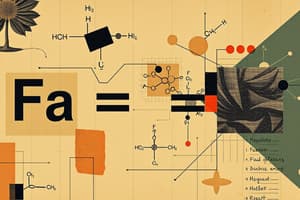Podcast
Questions and Answers
Hydroxide
Hydroxide
- O2
- H2O
- H3O+
- OH- (correct)
Phosphate
Phosphate
- PO3^3-
- PO4^3 (correct)
- P2O5^3-
- P2O7^4- (correct)
Nitrate
Nitrate
- NO3- (correct)
- N2O
- NH4+
- NO2-
Carbonate
Carbonate
Sulfite
Sulfite
NH4+
NH4+
Identify the chemical formula that represents the nitrite ion.
Identify the chemical formula that represents the nitrite ion.
Which of the following represents the chemical formula for the chlorite ion?
Which of the following represents the chemical formula for the chlorite ion?
What is the chemical formula for the chlorate ion?
What is the chemical formula for the chlorate ion?
Flashcards
Hydroxide
Hydroxide
OH-
Phosphate
Phosphate
PO4^3-
Nitrate
Nitrate
NO3-
Carbonate
Carbonate
Signup and view all the flashcards
Sulfite
Sulfite
Signup and view all the flashcards
Ammonium
Ammonium
Signup and view all the flashcards
Nitrite
Nitrite
Signup and view all the flashcards
Sulfate
Sulfate
Signup and view all the flashcards
Chlorite
Chlorite
Signup and view all the flashcards
Chlorate
Chlorate
Signup and view all the flashcards
Study Notes
- Study notes for Quiz Review
Key Chemical Formulas
- Hydroxide: OH-
- Phosphate: PO4-3
- Nitrate: NO3-
- Carbonate: CO3-2
- Sulfite: SO3-2
- Ammonium: NH4+
- Nitrite: NO2-
- Sulfate: SO4-2
- Chloride: ClO2-
- Chlorate: ClO3-
Logic and Quantifiers
- A statement is a declarative sentence that is either true or false but not both.
- A statement can be simple or compound.
Connectives
- Compound statements get created using logical connectives such as and, or, if... then, if and only if, and not.
- If p and q are statements:
- Negation of p (¬p) is the statement "not p". ¬p is true when p is false, and vice versa.
- Conjunction of p and q (p ∧ q) is the statement "p and q". p ∧ q is true if both p and q are true, otherwise false.
- Disjunction of p and q (p ∨ q) is the statement "p or q". p ∨ q is true if at least one of p or q is true, otherwise false.
- Implication of p and q (p ⇒ q) is the statement "if p, then q". p ⇒ q is false if p is true and q is false, otherwise true. p is the hypothesis and q is the conclusion.
- Double implication of p and q (p ⇔ q) is the statement "p if and only if q". p ⇔ q is true if both p and q are true or both are false, otherwise false.
- The symbol ":=" means "defined as".
Examples of Statements and Connectives
- Let p = "It is raining" and q = "It is cold":
- ¬p : "It is not raining."
- p ∧ q : "It is raining and it is cold."
- p ∨ q : "It is raining or it is cold."
- p ⇒ q : "If it is raining, then it is cold."
- p ⇔ q : "It is raining if and only if it is cold."
Tautology and Contradiction
- Tautology: A statement that is always true.
- Ex: p ∨ ¬p
- Contradiction: A statement that is always false.
Studying That Suits You
Use AI to generate personalized quizzes and flashcards to suit your learning preferences.




